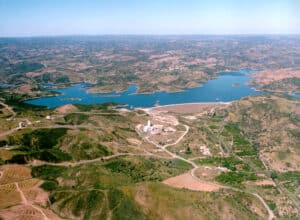Water highway south from Alqueva ‘under consideration’
Little more than a year ago, Público wrote: “Portugal has no strategy for water, but uses it at will”. Since then, there have been elections – eight years of Socialism have been replaced by a minority centre-right government (with no working majority, but a lot of ideas) and now, as the country approaches a new year, southern areas so blighted by water scarcity have a whole new future ahead of them.
Minister for Environment and Energy Maria da Graça Carvalho was in Faro last Sunday to lay out the various plans and blueprints.
She stressed that she sees it as her ‘mission’ to “get the Algarve ready” for the relentless desertification that experts and meteorologists have been warning about for the best part of the last two decades.
“The Algarve has very serious problems,” she said, outside the ‘Pavilhão da Água’ (water pavilion) erected for the festive season. “It needs a lot of water for agriculture, tourism and human consumption. We cannot let it become arid because that would be very bad for the economy and for quality of life. The Algarve is a marvellous region, but it needs water to be a marvellous region.”

And thus the host of initiatives, many of which had been on the back burners of past administrations but which are now being actively fast-forwarded.
Perhaps the greatest novelty of Sunday was the fact that this government is indeed looking into the possibility of a water highway south – in this case, using the massive Alqueva reservoir in the Alentejo as the source.
Water highways are a ‘moot point’, in that some environmentalists argue vehemently against them, suggesting they carry too many environmental costs, and are not, effectively, doing anything to boost water supplies (they are simply moving water around).
Equally, some engineers and academics champion the concept of water highways, particularly from the north (which often has too much water). Indeed, a pipeline connecting with the north has been something AMAL (the intermunicipal community of the Algarve) has said may be worth investigating.
But on Sunday, minister Carvalho stated that a water highway from Alqueva is now very much under consideration.
A study is being carried out to supply water to the Algarve from Alqueva, via the Santa Clara dam (another water source that has been ‘bled to dead level’ by agricultural explorations on the west coast).
The idea is that water would feed from Alqueva first to Santa Clara, and then on to Barragem da Bravura (arguably one of the Algarve’s most compromised dams, just north of Lagos).
Minister Carvalho stressed that the concept is only possible thanks to Spain’s authorisation for ‘abstraction of 60 cubic hectometres (60 million cubic metres) from the Guadiana River’.
She explained: “As long as the ecological flows of the Guadiana River are guaranteed, it will be possible to use 30 cubic hectometres of water from Pomarão (to feed to the Odeleite reservoir) and 30 cubic hectometres to reinforce Alqueva.
“Through this reinforcement of Alqueva, it will be possible – and this is what we are currently studying – to connect Alqueva to the Mira Basin, therefore to Santa Clara, and from Santa Clara to the Bravura Dam.”
“We will thus be supplying water to the Barlavento and Sotavento regions,” she added, “giving greater water resilience to the Algarve”.
Sunday was partially about launching the tender for the construction of the water intake project in Pomarão, but also about signing protocols that pave the way to supplying water access solutions for the compromised rural populations of Mesquita and Espírito Santo, in Mértola (Beja district), which will finally be connected to mains water – and to the creation of two ‘river reserves’.
The so-called ‘integrated intervention’ – planned with €40 million of funding from the Regional Operational Programme – will create one river reserve on the Vascão River (a tributary of the Guadiana), in the Sotavento Algarve, and another on the Ribeira de Odeceixe, in the west, above Aljezur.
“These will be two extremely important river reserves for our country,” said the minister, recalling also that Portuguese Environment Agency APA, in conjunction with the Municipal Council of Mértola, is preparing studies for the renaturalisation of the banks of the Guadiana.
This particular project is included in the reprogramming of the Plan for Recovery and Resilience (PRR), with a budget of €10 million being proposed to the European Commission to make the Guadiana “beautiful and renaturalised” – not using its water solely “for socio economic purposes”.
Lastly, Sunday’s visit to Faro also saw the signing of a protocol between Castro Marim Council and Águas do Algarve to promote the rehabilitation of the Castro Marim sanitation network “with the aim of reducing the undue inflow of brackish water and, thus, promoting the availability of water for reuse by the agricultural and golf sectors”.

The government only came into ‘power’ (and even that is a strong word, given its non-existent majority) eight months ago, but, in that time, it has powered forwards with policies and plans which it sees as ‘for the good of the country’.
Yes, there will always be detractors who say the policies are misguided – particularly when it comes to the multimillion-euro initiative to construct a desalination plant behind one of the most iconic beaches of the Albufeira coastline.
But minister Carvalho is resolute: “The desalination plant will produce around 24 cubic hectometres of water (annually), and the connection to Pomarão, 30 cubic hectometres. Human consumption is around 75 cubic hectometres.
“Today, the Algarve is in a situation where there is less and less rainfall, a trend of the last 20 years. It is a whole desertification front that is moving northwards into Europe. Today, Malta survives on a desalination plant and the reuse of water, it has no other source. At the moment, there is funding that may not exist in the future. My mission is to get the Algarve ready.”
As Lusa stressed on Sunday, Maria da Graça Carvalho also recalled that Spain, by comparison, “has more than 700 desalination plants. Cape Verde has eight and is building its ninth. It had its first in the 1950s in Mindelo, built during Salazar’s time. Technologies have evolved a lot, and we can’t waste any more time discussing desalination in the Algarve region”.
Legal challenges in place may end up ‘standing for nothing’, as the minister told Expresso in October that the Council of Ministers has passed a decree law to impede them from halting any and all works in PRR projects.
By NATASHA DONN
natasha.donn@portugalresident.com


























